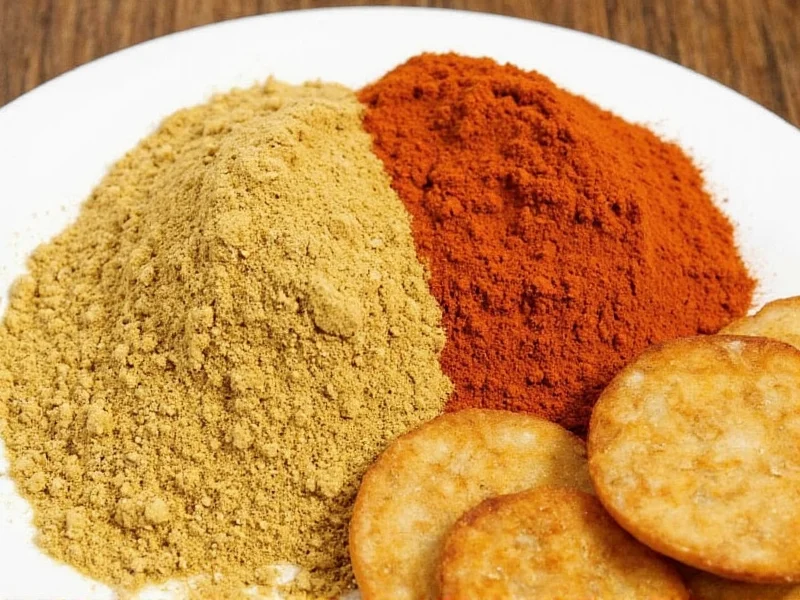When you're in the middle of cooking and realize you're missing either curry powder or curry paste, knowing how to properly substitute becomes essential. While these ingredients share similar names, they have distinct compositions that affect flavor, texture, and overall dish quality. Understanding the proper substitution technique can save your meal while maintaining authentic curry characteristics.
Understanding Curry Powder vs Curry Paste
Curry powder and curry paste serve different culinary purposes despite their similar names. Curry powder is a dry spice blend typically containing turmeric, coriander, cumin, fenugreek, and chili powder. In contrast, curry paste is a wet mixture featuring fresh ingredients like lemongrass, galangal, kaffir lime leaves, shrimp paste, and chilies blended with oil or water.
| Characteristic | Curry Powder | Curry Paste |
|---|---|---|
| Form | Dry spice blend | Wet paste |
| Moisture Content | Negligible | High (30-50%) |
| Key Ingredients | Dried spices only | Fresh aromatics + dried spices |
| Flavor Profile | Earthy, warm | Bright, complex, layered |
| Shelf Life | 6-12 months | 1-2 months refrigerated |
Proper Substitution Ratios and Techniques
Substituting curry powder for curry paste requires careful adjustment to maintain your dish's intended flavor profile. The standard conversion is 1-2 teaspoons of curry powder per tablespoon of curry paste, but this varies based on the specific recipe and curry type.
When making the substitution, remember these critical adjustments:
- Add 1-2 tablespoons of liquid (coconut milk, broth, or water) per tablespoon of curry paste replaced
- Include fresh aromatics like minced garlic, ginger, or lemongrass to compensate for missing fresh ingredients
- Consider adding a small amount of tomato paste for depth and color
- Adjust seasoning at the end as curry powder may contain salt while paste typically doesn't
Recipe-Specific Substitution Guidance
The success of your substitution depends heavily on the specific curry you're preparing. Different regional curries have distinct flavor profiles that require tailored approaches:
Thai Curries
Substituting in Thai recipes presents the greatest challenge since Thai curries rely heavily on fresh ingredients in the paste. For red or green Thai curry:
- Use 1.5 teaspoons of curry powder per tablespoon of paste
- Add 1 tablespoon each of minced lemongrass, galangal (or ginger), and kaffir lime zest
- Include 1 teaspoon fish sauce for umami depth
- Stir in fresh lime juice at the end to brighten flavors
Indian Curries
Indian curry substitutions are generally more straightforward since many Indian "curry powders" were originally created for Western markets:
- Use 1 teaspoon curry powder per tablespoon of paste
- Add 1 tablespoon tomato paste for body
- Include 1 teaspoon garam masala for complexity
- Consider adding a pinch of asafoetida (hing) for authentic depth
Common Substitution Mistakes to Avoid
Many home cooks make critical errors when substituting these ingredients that compromise their final dish:
- Using equal measurements - This creates an overly dry, spice-heavy dish
- Ignoring moisture content - Results in a sauce that's too thick and lacks proper consistency
- Not compensating for fresh ingredients - Missing the bright, herbal notes that define many curry pastes
- Adding all spices at once - Better to bloom curry powder in oil first, then add liquid gradually
- Not tasting and adjusting - Always taste after 10-15 minutes of simmering and adjust seasoning
Alternative Substitutes When Neither Is Available
If you lack both curry powder and paste, these alternatives can rescue your recipe:
- Homemade quick paste: Blend 2 tablespoons oil, 1 tablespoon each minced garlic/ginger, 1 teaspoon turmeric, 1 teaspoon cumin, and 1/2 teaspoon chili powder
- Garam masala approach: Use 2 teaspoons garam masala plus additional turmeric and cayenne to taste
- Curry leaf solution: Sauté 8-10 fresh or dried curry leaves in oil with standard spices for authentic flavor
- Ready-made alternative: In a pinch, use 2 tablespoons of good-quality harissa or berbere spice blend diluted with coconut milk
When Substitution Works Best
Understanding which dishes tolerate substitution better can prevent cooking disasters. Curries with longer simmering times (like stews or braises) handle substitutions better than quick-cooking dishes. Coconut milk-based curries are more forgiving than tomato-based ones, as the fat content helps distribute dry spices more evenly.
For best results, add curry powder early in the cooking process to allow flavors to bloom and integrate, while curry paste can be added later since its flavors are already developed. When substituting, add the powder first to toast in oil, then incorporate your liquid components.











 浙公网安备
33010002000092号
浙公网安备
33010002000092号 浙B2-20120091-4
浙B2-20120091-4